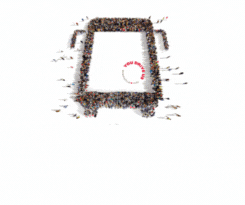
Photo: Navtech-Radar
How radar technology can make airports safer
03 September 2013
by Richard Forster
Covering several tens of square kilometres, airports are by their very nature an exceptional physical security challenge and offer a high-value target for terrorists and criminals. While many people associate airport security with matters inside the terminal, Nick Michell looks at how new radar technology is proving that security at the perimeter is just as important.
Due to the sheer volume of people and vehicles going in and out of the perimeter of airports, the security challenges for cities are immense. Passengers expect quick and easy access to airport terminal buildings; freight shippers demand the same ease of access to warehouses; aircraft, service vehicles and ground crew need unfettered movement airside; and the multitude of employees, upon whom the whole operation depends, must get to work.
These unique circumstances render the use of physical barriers difficult if not impossible and such manpower- intensive, human systems vary in their effectiveness and need close monitoring, adding further to cost and complexity.
For many years, military and critical infrastructure installations, such as nuclear power stations, have used radar to address the conflict between operational and security criteria and now commercial-grade systems are available which offer a similar solution for airports. At Bristol Airport, in the southwest of England, a recent deployment of Navtech Radar’s detection and monitoring system is proving the effectiveness of the technology.
“There are a small number of alternative radar technologies on the market and most are focused on military applications and require manned operation,” says Philip Avery, Managing Director of Navtech Radar, which manufactures commercial radar solutions for outdoor applications. “Navtech’s AdvanceGuard system delivers fully automatic operation with programmable rules based alarm generation enabling the system to provide pseudo-intelligent surveillance of a wide area. This allows the system to be used in busy environments such as airports and still provide comprehensive coverage with very low false alarm rates.”
Because reaction times will be largely dictated by the distance security personnel have to cover to reach an incident, a low false alarm rate is vital in order to maintain users’ confidence in the system. It should also provide continual monitoring of large areas over extended distances in all weathers, a combination that raises issues for vision-based systems.
Bristol Airport uses a CCTV solution to protect almost all of its perimeter area, although the close proximity of a Critical Point to an area of open ground was deemed a security risk and additionally monitored by manned guards.
Vision-based systems and video analytics were considered when the UK Department for Transport directed that security on this portion of the airport adjacent to the flying club should be upgraded. But thick fog and heavy rain are common at Bristol Airport and test solutions failed to detect and track all incursions into the area under observation. Schneider Electric, the overall project leader for the security upgrade at Bristol Airport, turned to strategic technology partner Navtech Radar to provide a possible solution.
“Schneider Electric recommended AdvanceGuard based on its all-weather capabilities and operational experience at other airports,” says Chris Ware, Head of Security at Bristol Airport. “A further major factor was that the solution demonstrated the lowest false alarm rate as well as offering superior track and trace capability.”
Technical specifications of the system
To provide coverage of the Critical Point and its approaches, Navtech’s engineers installed a compact, high- performance, 360° scanning radar sensor, the AdvanceGuard AGS800-X. This unit will scan a full 360° every second to a radius of 600 metres with a resolution of 25-50 centimetres and is capable of detecting vehicles, humans and animals in all weather conditions. The AGS800-X is housed in a lightweight, IP67-compliant enclosure and features an industry-standard interface for easy integration and use as part of a multi-radar solution.

Scanning radar solution
The radar system is supported by Navtech’s sophisticated back office processing and control software called Witness. A suite of six integrated modules, Witness manages all system functions, from tracking targets and controlling cameras to handling the complex algorithms that analyse target behaviour and assign threat levels, and allows users to define detection zones and the rules that dictate when alarms are triggered. In this respect, radar is much like video and other sensors. The sensor provides as much information as it can but the full realisation of its importance is down to the sophistication of the post-processing software.
“It is very difficult to detect and respond to intruders over such a wide area as is typical for an airfield,” says Avery. “With AdvanceGuard, the security team have full situation awareness over the whole of the coverage area inside and outside the perimeter and this enables a quick measured response to any illicit activity.”
Using Sentinel, the intuitive on- screen interface offered by Witness, users can draw active detection zones.
At the simplest level, it can replace physical barriers with ‘virtual gates’ that allow unrestricted movement but enable users to monitor and, if necessary, change their status. For instance, at specific times during the day it might be that a watch needs to be kept on vehicles or people moving in one direction but not another; or, that any movement is permitted in one area but a total prohibition zone needs to be safeguarded elsewhere. With virtually no limit to the complexity of the rules that can be applied with the software, a level of pseudo-intelligent monitoring can be introduced that closely mimics a human observer. While video analytics may appear to be able to do many of the same things, in practice they have limited coverage, and do not have accurate speed, direction and location information, as well as being affected by environmental conditions.
Critical point protection
Bristol Airport established a warning area around the unsecured critical point so that any encroachment by potential intruders results in an alert being received by the operators. All potential threats within the warning area are displayed on Sentinel and are updated in real-time. Running on top of this, a sophisticated set of direction rules, complete with geo-fenced alarm zones, allows Witness to generate alerts only when a threat moves into the critical point from the direction of the flying club.
“Traditional perimeter detection systems have significant limitation for wide area coverage so once an intruder has breached the perimeter it is not possible to detect where they are or where they have been,” says Avery. “This can mean the airport has to be closed until the situation is resolved. AdvanceGuard gives vital information to help quickly resolve any incidents.”

While the combination of AdvanceGuard radar and the Witness control system provides comprehensive wide-area detection and tracking capability, some form of visual confirmation of an incident is still necessary and Navtech Radar can be integrated with camera systems. At Bristol Airport, AdvanceGuard and Witness have been integrated with an Esprit TI thermal imaging camera supplied by Pelco, part of the Schneider Electric group, which is capable of tracking any identified threat using bearing and range instructions provided by Witness.
“As tested, market-ready products, AdvanceGuard and Witness met the short lead times necessary for our high-priority project and good on-site and remote support from Navtech Radar helped to smooth the installation process,” says Bristol Airport’s Ware. “The system’s very low false alarm rate, which was proven during testing, and its ability to work in fog all weather conditions have affirmed the choice.”
The system’s alarm log and operator acknowledgement features also provide an audit trail for both employer and employee. Staff can be seen to have followed procedures because there is now a security system in place that documents that they have done so.
Upgrading the technology
Bristol Airport has now upgraded to Witness 2, which features a classification module using complex algorithms to evaluate target characteristics. Intrusions can now be classified as a person or a vehicle and the system user can mount an appropriate response. A track history visualisation system enables users to review the details of previous incursions based on criteria such as time, location and so on. A complete track history can then be displayed on the system’s user interface, enabling the user to see exactly where an intrusion took place and where the intruder went within a site.
The new radar has already been integrated with Bristol’s existing CCTV system. This includes the use of relays to trigger the cameras to move to cover pre-set areas and increases ease of use.
To date, most of the focus for airport security has been inside the terminal building, and this has taken attention away from the perimeter and airfield itself.
But as security issues become complex and as passenger traffic increases, radar technology for perimeters will be an essential component to the efficient running of a modern airport.







